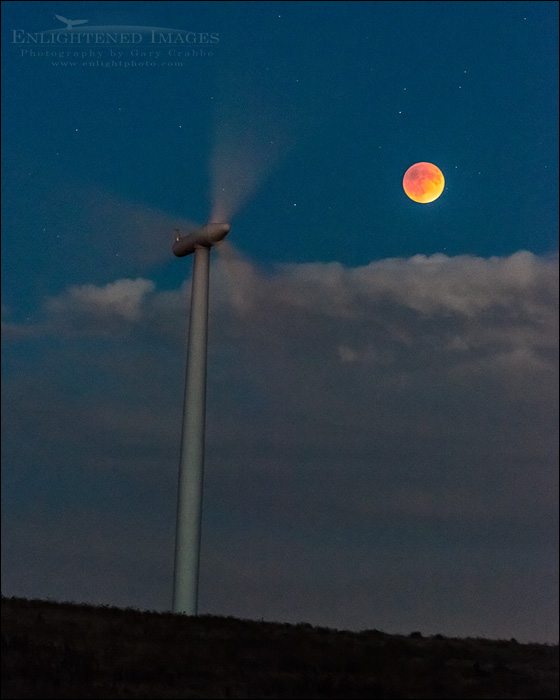
Picture: Super-Blood-Harvest Moon during a Lunar Eclipse next to wind turbine, Solano County, California (Sept. 27, 2015)
It’s not often that you see photographers, especially professionals, show off their failures. When I teach in workshops, do private consultations or portfolio reviews, one of the things I always ask my students / clients is to see samples of their work. Although seeing their best images is always nice, from an educational standpoint, it means very little when compared to looking at their failures. When you look at the trophy shots, you see how well someone does when they get everything right. Far more revealing when I’m trying to teach about photography is to see some of their failures; the shots that didn’t turn out like they expected, or that reveal issues someone is struggling to overcome. The idea of exploring and understanding why a shot didn’t work out as anticipated is a paramount step when trying to improve one’s photographic vision or skills, especially with newer photographers who may not be extremely well-versed with concepts of composition or exposure.
Here’s a shot I had previsualized for last week’s Super-Blood-Moon lunar eclipse. It is almost as I envisioned, but due to circumstances beyond my control, it has enough technical problems that it shall live in my “almost” file. In the immortal words of famous agent, Maxwell Smart: “Missed it by that much!”
In an age when many photographers are putting together amazing composite blended images made from multiple frames, I intended to capture the eclipse with a single frame. The goal was to catch the eclipse low in the sky as it rose with the pinkish-purple hues of dusk, and at a moment in time when the exposure for the moon and the sky would be the equal, yet would also allow me to shoot with a fast enough shutter speed to show the turning turbine fan blades in motion.
The problem: Clouds. The weather gods did not fully cooperate with those of us in the San Francisco Bay Area. A ridge of high clouds was drifting slowly eastward overhead throughout the course of the day. But when push came to shove, the clouds didn’t clear out fast enough. Rather than seeing the moon rise just above the horizon, it took nearly three-quarters of an hour for the already eclipsed moon to appear above the clouds in the sky. In that amount of time, the ambient light in the sky had darkened so much that the only way I could capture the spinning blades of the turbine was to raise my ISO to 3200 while keeping my exposure speed at or under one second. Any longer of an exposure time, especially enough to have more light in the sky and clouds, caused the spinning blades to be rendered completely invisible. I mean after all…what’s a windmill look like with no blades? Just a pole in the evening sky. That’s not what I envisioned at all.
Even though I was shooting with a D800, by the time I opened up the exposure on the resulting RAW file in Lightroom, there was just far too much digital noise and color pollution in the lightened frame to make what I’d call a successful “keeper” shot. If the clouds hadn’t been there, and the moon had been low on the horizon right at twilight, I would have perfectly nailed the shot I’d envisioned. (The one thing I did have to do digitally to salvage this shot was to use a luminosity mask to control the exposure of the moon.)
Oh well. C’est la vie. I’ll have another chance to get this shot right in another 18 years. (God willing.)
Picture: Super-Blood-Harvest Moon during a Lunar Eclipse (Sept. 27, 2015)
Here’s what the eclipse looked like during a straight shot, also at 3200 ISO. Without trying to brighten the exposure, the high ISO noise in this frame is nowhere near problematic.

—
![]()
If you like this post , I would greatly appreciate it if you’d consider sharing this with your friends using one of the Social Media sharing buttons located at the top or bottom of this post. You can also < href=https://enlightphoto.brownrice.website/news.htm>sign up to receive free updates by email when future posts are made to this blog.
![]()
—
Image ID#: 150926_BA-0298
—
Gary Crabbe is an award-winning commercial and editorial outdoor travel photographer and author based out of the San Francisco Bay Area, California. He has seven published books on California to his credit, including “Photographing California; v1-North”, which won the prestigious 2013 IBPA Benjamin Franklin Gold Medal award as Best Regional title. His client and publication credits include the National Geographic Society, the New York Times, Forbes Magazine, TIME, The North Face, Subaru, L.L. Bean, Victoria’s Secret, Sunset Magazine, The Nature Conservancy, and many more. Gary is also a photography instructor and consultant, offering both public and private photo workshops. He also works occasionally a professional freelance Photo Editor.

I still think it’s a beautiful shot Gary. A keeper in my book. Noise reduction is your friend. 😉
The mark of a great photographer is someone who makes great things from less than ideal circumstances. This still looks quite good to my eye. A photographers goals and ideas can sometimes hinder their perspective after the fact. There’s always the next lunar eclipse to try again. Keep up the great work Gary!